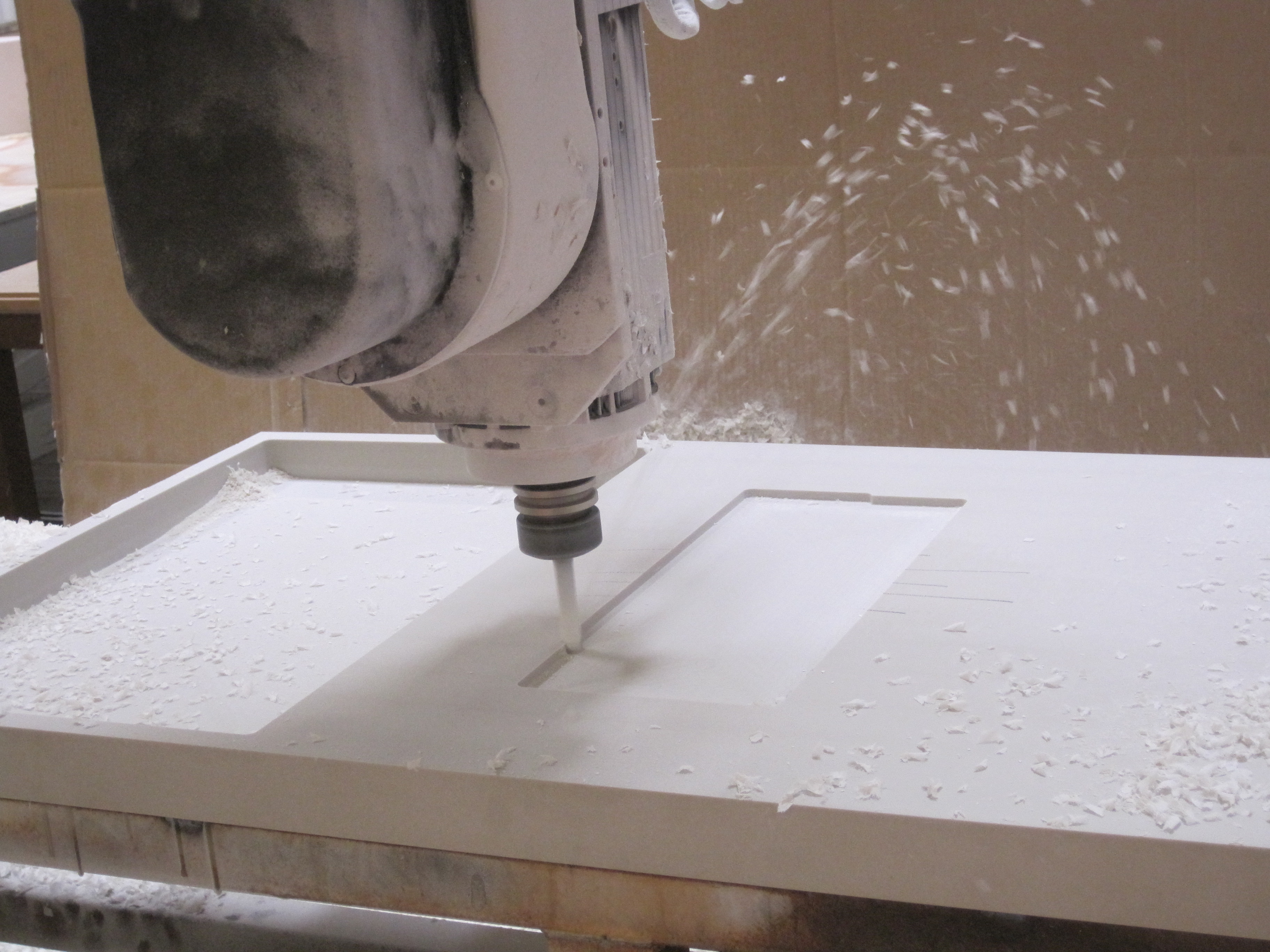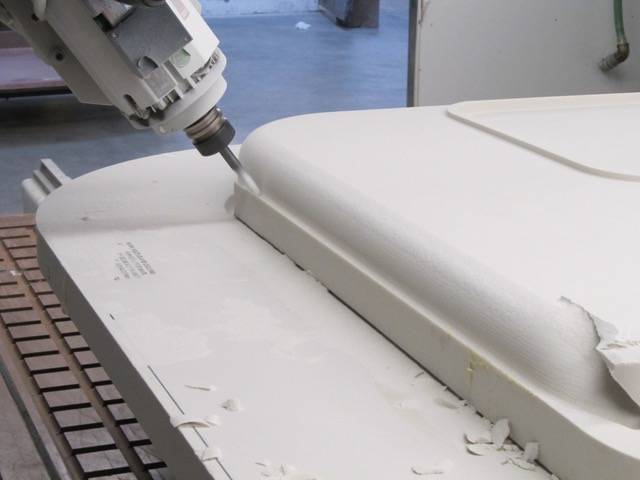We often get asked about optimal speeds and feeds settings for CNC routing of Precision Board HDU. While there is a lot of great information on our website about feeds and speeds, what doesn’t get talked about as much is something called “chip load”. Chip load can be defined as the size or thickness of the chip that is removed with each flute per revolution. There are many factors that go into calculating chip load, so we’ve put together this blog with information from router bit manufacturer LMT Onsrud and CNC manufacturer AXYZ Automation Group. Using the information in this blog, and with a little experimentation, you will be able to dial your settings in to achieve greater CNC efficiency when routing HDU. Clean, sharp edges, a smooth cutting surface and potentially shortened cutting time are all benefits of optimized CNC router settings.
LMT Onsrud
LMT Onsrud is a premium cutting tool manufacturer servicing the metal working, composite, wood and plastics (HDU) industries. Their tooling can be found within various industrial markets – aerospace, medical, composites, plastics, woods – and are used in making the products you use on a daily basis.
The proper cutting tool used with speeds and feeds information lets you achieve optimum chip load. Proper chip load allows the cutting tool to move in and out of the material quicker, leading to more efficient CNC machining.
You can optimize your chip load by setting the feed rate and cutter speed to yield the largest chip that produces the desired surface finish. Precision Board HDU is non-abrasive, which also prolongs tool life.
Here’s a useful formula:
Chip Load = Feed rate/ RPM x # of flutes
To increase chip load:
Increase feed rate
Decrease RPM
Use a cutter with fewer flutes
To decrease chip load:
Decrease feed rate
Increase RPM
Use a cutter with more flutes
Check out this video from Onsrud where they explain in more detail how to calculate speeds and feeds.
They reference a chart in the video with formulas to calculate chip load as well as speeds and feeds. You can view a version of that below.

AXYZ Automation Group
AXYZ Automation Group is a leading global manufacturer of CNC router systems and CNC knife systems. Designed and built at their state-of-the-art factory in Canada, AXYZ CNC routers are supplied and supported through a global network of sales and support offices and authorized dealers. With more than 366,918 standard machine configurations, AXYZ specializes in matching machinery to customer’s unique needs and budgets.
They have an excellent website with valuable information on CNC routing. You can find that resource HERE.
The following information is from an article of theirs on feeds and speeds and chip load.
Calculating Feeds and Speeds
When material is machined the cutter must revolve at a specific RPM and feed at a specific feedrate to achieve the proper Chip load. There are also several factors to be considered when choosing the proper RPM and feedrate.
The feed rate used depends upon a variety of factors, including power and rigidity of the machine, rigidity of part hold-down, spindle horsepower, depth and width of cut, sharpness of cutting tool, design and type of cutter, and the material being cut.
To obtain the optimum Chip load, we must consider the variables listed above, along with the machine and materials we intend to cut. This will help us find the best feed rate and RPM for any given tool and material.
One thing to remember is to make chips not dust. Chips will help by removing the heat produced in the cutting process thus increasing tool life and improving edge quality.
Feed rate is calculated using the following equation:
Feed = N x cpt x RPM
N – number of cutting edges (flutes)
cpt – chip load (chip per tooth) is the amount of material, which should be removed by each tooth of the cutter as it rotates and advances into the work. (mm per tooth)
RPM – the speed at which the cutter revolves in the spindle. (Revolutions per minute)
We will now break down the relationship between the Feed rates, number of cutting edges, chip load and RPM. For most materials there is a recommended chip load.
If you are running at 18000 RPM using a 25mm endmill with two flutes, and a recommended chip load of 0.1 mm/tooth:
Feed = 2 x 0.1 x 18000 = 3600 mm per min
If the RPM were increased to 24000 RPM the new feed rate would work out to be:
Feed = 2 x 0.1 x 24000 = 4800 mm per min

Based on this mathematical equation, as RPM increases, feed rate will also increase if all other settings remain the same. If the number of cutting edges changes, however the feed rate will either increase or decrease depending on the whether the number goes up or down. The same applies to chip load if the recommended chip load is 0.1 mm/tooth the RPM, feed or number of cutting edges may go up or down to maintain the required chip load. Therefore if chip load remains the same, and feed rate increases, either the RPM and or number of cutting edges must increase to maintain the recommended chip load.
When calculating the feed rate for any material the chip load is therefore one of the most important factors to be taken into account because the chip load determines the amount of material that each tooth will remove, plus the load that each tooth will have to take. Another factor that affects chip load is the diameter of the cutter. A larger cutter will be able to handle a larger chip load.
| No of teeth | cpt (mm) | Feed rate (mm per min) at RPM |
||
| 18000 | 21000 | 24000 | ||
| 1 | 0.1 | 1800 | 2100 | 2400 |
| 2 | 0.1 | 3600 | 4200 | 4800 |
| 3 | 0.1 | 5400 | 6300 | 7200 |
| 1 | 0.4 | 7200 | 8400 | 9600 |
| 2 | 0.4 | 14400 | 16800 | 19200 |
| 3 | 0.4 | 21600 | 25200 | 28800 |
Therefore depending on the diameter of the tool, if the RPM and number of cutter edges stay the same chip load will increase with a larger diameter cutter, thus the feed rate will also increase. When machining softer materials or using a stubby router bit the chip load can be increased. If an extra long router bit is being used, the chip load should be decreased.
For most material that you will be cutting on an AXYZ router table you will typically set the RPM between 18000 and 24000, and adjust your feed rate to obtain the required results. On an AXYZ router table we use spindles that produce a maximum of 24000 RPM. The speeds and feeds chosen can be affected by the horsepower of the spindle being used (horsepower varies from 3Hp to 10 Hp). At higher horsepower you will produce more torque thus allowing the machine to run at a variety of RPM’s (torque drops off as the RPM is reduced). For most application we typically work in the 18000 to 22000 RPM range.
Typical Chip Load Values for Various Size Cutters |
||||||
| Tool Diameter | Hard Woods | Softwood / Plywood | MDF / Particle Board | Soft Plastics | Hard Plastics | Aluminium |
| 3mm | 0.08 – 0.13 | 0.1 – 0.15 | 0.1 – 0.18 | 0.1 – 0.15 | 0.15 – 0.2 | 0.05 – 0.1 |
| 6mm | 0.23 – 0.28 | 0.28 – 0.33 | 0.33 – 0.41 | 0.2 – 0.3 | 0.25 – 0.3 | 0.08 – 0.15 |
| 10mm | 0.38 – 0.46 | 0.43 – 0.51 | 0.51 – 0.58 | 0.2 – 0.3 | 0.25 – 0.3 | 0.1 – 0.2 |
| 12mm and over | 0.48 – 0.53 | 0.53 – 0.58 | 0.64 0.69 | 0.25 – 0.36 | 0.3 – 0.41 | 0.2 – 0.25 |
Even though there are formulas for calculating feed rates you will find that optimum feed rate will be determined from experience. You will typically start off with the calculated feed rate. Under ideal conditions it is usually suggested that the actual feed rate be set to approximately one-half the calculated amount and gradually increased to the capacity of the machine and the finish desired.
Once you have determined what feed and speed to start with, there are other factors to be taken into consideration. The next thing to be considered is the direction of cut, which is the direction the cutter is fed into the material. Conventional milling or cutting forward is the most commonly used method. With this method the work is fed against the rotation direction of the cutter. The other method is climb milling or cutting reverse. For this machining method the workpiece and the machine must be rigid. The AXYZ router machine is such a machine. When machining non-ferrous materials, climb cutting should be used to achieve a good finish.
Another factor is depth of cut. Depth of cut will effect edge finish as well as tool life. You will have to adjust your depth to achieve the desired results depending on the type of material and size of cutter. Usually a depth of cut that equals the radius of the cutter is a good starting point when cutting non-ferrous metals.
Conclusion
By experimenting with these different speeds and feeds settings, and using the chip load formula that works best for you, it’s possible to maximize your CNC efficiency. Always remember to make chips and not dust. This can potentially speed up your cutting time and help you to achieve clean, sharp edges and a smooth routing surface on your HDU. Trying a variety of cutting tools and settings will also add life to your CNC machine and save wear and tear on your cutters. When in doubt, consult the manufacturer of your CNC for best practices on chip load for your particular CNC machine.
About Coastal Enterprises
Coastal Enterprises manufactures Precision Board HDU, a versatile, cost-effective and eco-friendly urethane material used extensively in the tooling industry. It is a closed-cell rigid substrate that does not rot, warp or crack. You can request free samples, get a quote or sign up for periodic newsletters packed with helpful information.

